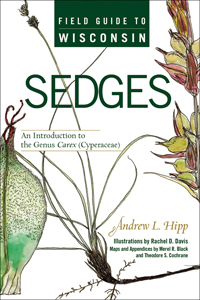Field Guide to Wisconsin Sedges
An Introduction to the Genus Carex (Cyperaceae)
Andrew L. Hipp
Illustrations by Rachel D. Davis
Maps and Appendices by Merel R. Black & Theodore S. Cochrane
For both botanists and gardeners, a full-color introduction to an important genus of wetland plants that make up about 7 percent of the flora of the Upper Midwest
Sedges are among the world’s most diverse and ecologically important plant families, with almost two hundred species in Wisconsin alone. These grass-like plants, found mostly in wetlands, are increasingly popular with landscapers and home gardeners. Learning to identify sedges is challenging, however, and the available technical guides to the sedge family can be overwhelming to a nonspecialist. Field Guide to Wisconsin Sedges is a beautifully illustrated introduction to the largest sedge genus, Carex, which alone makes up about 7 percent of the flora of the Upper Midwest.
Written primarily for naturalists, wild plant enthusiasts, and native landscapers, this book is unique in its accessible format and illustrations. With this book, readers can learn to recognize key structures needed to identify approximately 150 Carex species found in Wisconsin. Author Andrew Hipp shows how to identify many of the major groupings of sedges that are used in guides to the genus throughout the world. For botanists who are not experts on sedges, he also provides guidelines for distinguishing among similar species. Readers should be able to identify more than 90 percent of the sedges they find in the field using no more than this guidebook and a hand lens.
Field Guide to Wisconsin Sedges includes information on habitat
and range drawn from Hipp’s extensive field experience and inspection of thousands of herbarium sheets. Primarily an identification guide,
it is a helpful source of information for landscapers, gardeners, and
restorationists.
Published in collaboration with the University of Wisconsin Arboretum and the University of Wisconsin–Madison Department of Botany
Features:
• Keys to all Wisconsin Carex species, arranged by section
• Distribution maps for all species
• Species descriptions and detailed habitat information for more than 50 common species
• Color illustrations of whole plants or details for more than 70 species
• Appendix summarizing dominant Carex species by Wisconsin habitat
• A glossary of terms
• Water-resistant paperback cover
Andrew Hipp is the plant systematist and herbarium curator at the Morton Arboretum in Lisle, Illinois. He is the author of several natural history books for children, a field guide to spring woodland wildflowers of the University of Wisconsin–Madison Arboretum, and scientific articles on the taxonomy and evolution of Carex. Rachel D. Davis received her M.F.A. in printmaking at the University of Wisconsin–Madison.
Media & bookseller inquiries regarding review copies, events, and interviews can be directed to the publicity department at publicity@wwwtest.uwpress.wisc.edu or (608) 263-0734. (If you want to examine a book for possible course use, please see our Course Books page. If you want to examine a book for possible rights licensing, please see Rights & Permissions.)
|
|

March 2008
LC: 2007042153 QK
280 pp. 6 x 9
62 color illus., 157 maps
The cloth version of this title, ISBN 978-0-299-22590-2, is out of print.
“While targeting Wisconsin, the book is useful in a much larger area of the U.S. and Canada. The incredible illustrations and detailed key make this guide a great resource for beginning “sedgers.” Field Guide to Wisconsin Sedges will also open any reader to a new realm of plant identification.”
—Wildlife Activist
“Excellent guide.”
—Choice
|
